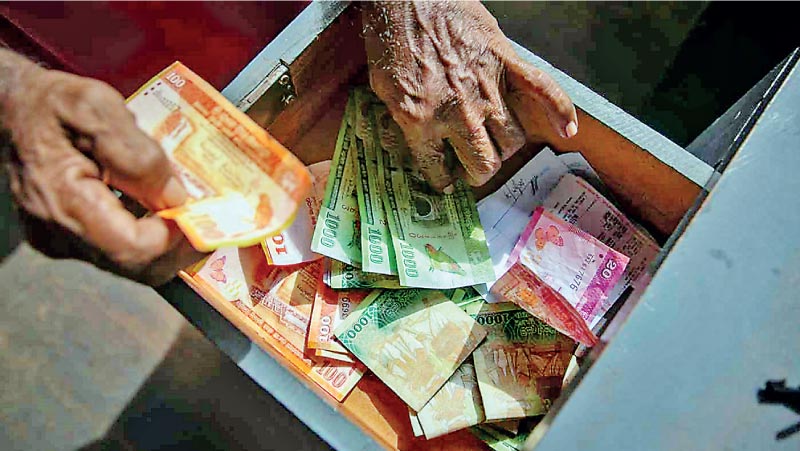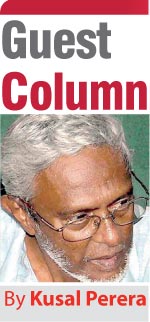Monday Apr 07, 2025
Monday Apr 07, 2025
Tuesday, 21 March 2023 00:49 - - {{hitsCtrl.values.hits}}

PTUA should have begun by questioning the validity of the estimated annual expenditure
 Professional Trade Union Alliance (PTUA), that came into action on 15 March last after the Wickremesinghe-led Government enforced a new tax scheme effective from January 2023, had presented to the Government their tax proposals titled “A Fair, Transparent and Accountable Taxation System for Sri Lanka”, before they went ahead with the pre-scheduled strike.
Professional Trade Union Alliance (PTUA), that came into action on 15 March last after the Wickremesinghe-led Government enforced a new tax scheme effective from January 2023, had presented to the Government their tax proposals titled “A Fair, Transparent and Accountable Taxation System for Sri Lanka”, before they went ahead with the pre-scheduled strike.
The day before on 14 March 2023 Secretary to President Wickremesinghe had replied to the GMOA President’s letter addressed to President Wickremesinghe informing the President’s willingness to discuss alternate proposals with the GMOA and other TUs. The reply also says, through constructive consultations it “should be possible to submit a viable proposal to the IMF at its first Review Meeting which will be held in a few months.”
Besides the IMF review meeting at the end of the year and submitting of proposals, it is important to open a social dialogue on the PTUA “tax proposals” they had taken pains to compile, though they themselves have not initiated a social dialogue on it. Their argument in it against “unfair and unethical” taxing by the Government sounds quite valid. “The new tax policy” as they say, “has imposed a heavy burden on the majority of the employees as their fixed income is taxed” while businesses are taxed only on “net income” which is basically the profit.
Yet their explanations on why “high taxes” are damaging to the country sound like mere abstract theoretical assumptions, outside real life. Numbers who earn increasing incomes through hard work and would be discouraged from productive contributions due to high taxes, I doubt would be worth enumerating. Most hardworking individuals can only be seen in the “informal sector” where employment and income are not guaranteed. In most instances they do not come within taxable incomes, despite hard work. Thus, assumptions far outside real life used in designing tax schemes are definitely problematic.
The story of “high taxes” and “hard work” is far different with professionals indulging in regular private practice and consultancies. Their total income with hard work or not, I believe is anyway rarely declared to the last Rupee as with most export businesses that do not repatriate their earnings to be parked here. “High taxes” would not deter them from earning more with enough “Tax Consultants” available for a decent fee. For ordinary employees in both the private and public sector, hard work does not increase monthly income as wages, allowances, maximum overtime pay possible, and incentives are pre decided. Yet “high taxes” per se should not be opposed without identifying where it is possible and where not.
First impression on tax proposals by PTUA that includes (i) short term (ii) intermediate and (iii) long term proposals is that professionals are conscious conservative thinkers. They limit themselves to “additions and adjustments” within the tax regime now in place. Firmly within free-market economics they have lost track of the past 40 years that led to serious and intolerable erosion in social ethics, discipline and responsibility, honesty, and integrity of personal and professional life.
Their short-term proposals on individual income tax are to increase taxation slabs from Rs. 500,000 to 600,000 per annum and increase the tax-free allowance to Rs. 2.4 million per annum. Also, to reduce the taxation rate to 4% from 6% and to work on increasing income slabs with multiples of 4% on taxation. These could be immediate relief to painfully affected professionals and that seems the galvanising factor for protests against IMF guided tax proposals.
Yet rest of the proposals in short, intermediate, and long term, are all designed with the belief this free market economy works best with a growing middle class that has opportunities to increase their disposable income for savings and investments. They also believe the new high tax policy reduces the middle class income substantially and that denies the “trickledown benefit” of the economy for many lower income social segments who rely on an affluent middle class. In short, they believe a pampered middle class is a necessity in a free market economy for “trickledown” effect.
“Trickledown” benefit is a lost case. It has been disputed from the time of US President Reagan. A journal article published in the “Socio-Economic Review” in its April 2022 issue by two Researchers David Hope and Julian Limberg of the London School of Economics, titled “The economic consequences of major tax cuts for the rich” covers taxation in 18 member countries from OECD during 50 years from 1965 to 2015. And they say, “We find tax cuts for the rich lead to higher income inequality in both the short- and medium-term. In contrast, such reforms do not have any significant effect on economic growth or unemployment. Our results therefore provide strong evidence against the influential political-economic idea that tax cuts for the rich ‘trickle down’ to boost the wider economy.”
That said, free-market economy no doubt is a big-city centred market that leaves out almost the entirety of the rural population from a productive economic life, leading to serious inequality in society not only in terms of income, but also in terms of access to essential services and facilities left wholly ignored outside big cities. Inherently corrupt it has already left the whole State apparatus ruined and rotten run by political leaderships sponsored and maintained by the filthy rich. There lies one major reason why the Inland Revenue Department and the other revenue collecting authorities like the Customs and the Excise Department fail in collecting the total income they are expected to collect annually.
This continuing deficiency in revenue collection has a flipside that needs serious attention before a tax policy is defined and decided upon. Collection of revenue is a necessity for any Government in meeting State expenditure. Sadly, there is no questioning of annual budget estimates on State expenditure in confirming accuracy and authenticity of estimates. A serious lapse in the approach adopted by PTUA experts.
These little details would prove why PTUA proposals are therefore out of track. They go without questioning the estimated expenditure for year 2023 as per the gazetted Appropriation Bill that stands at a grand total of Rs. 7,879,499 million. How much of this massive annual expenditure estimated close to Rs. 8 trillion is actual and necessary? I may not be exaggerating when I say, there are unwanted, wasteful, and fraudulent expenditures included that can be simply deleted to leave a realistic annual expenditure of around Rs. 4 trillion. An expenditure for which revenue should be collected and tax policy decided for.
Thus, PTUA should have begun by questioning the validity of the estimated annual expenditure. Where they could have begun is questioning allocations for parliament itself. I am one who is convinced the number 225 in the present parliament should be reduced to around 131 to have the total we had in the first bi-cameral parliament. That by itself would cut down the cost of maintaining a parliament. This giant parliament is provided with allocations that far exceeds what they should be allocated with. For 2023, the allocation is Rs. 3,699 million; an increase from Rs. 2,705 in 2021. That apart, the Leader of the House has Rs. 70 million, the Chief Government Whip has Rs. 159 million, the Leader of the Opposition has Rs. 219 million and the Office of the Parliamentary Commissioner for Administration has Rs. 56 million allocated. Again, under capital expenditure parliament is allocated Rs. 120 million, while separately the Leader of the House gets Rs. 1 million, Chief Govt. Whip gets another Rs. 1 million, Leader of the Opposition gets Rs. 20 million and Parliamentary Commissioner for Administration gets Rs. 0.3 million. All these need itemised details and justifications too.
There are ministries, departments and institutes including the President’s Office with massive allocations that need a heavy axe. For instance, the President’s Office is allocated with Rs. 505 million for recurrent expenditure, while it also has an allocation of Rs. 1,953 million for Gen. Admin and Establishment Service and another Rs. 300 million for Public Institutions and Special Agencies. Most staff positions in the President’s Office, especially those from the SLAS, the General Clerical Service and Government office assistants sure have all their expenses included under the Ministry of Public Administration. How will an allocation of Rs. 1,953 million for Gen. Admin and Establishment Service at the President’s Office therefore be justified? There is also the issue of the President having appointees totally out of the cadre with special privileges at heavy cost to taxpayers that should be severely restricted by a parliamentary decision.
All such expenditure in every ministry, department and public institute has to be questioned in detail to assess the actual public cost of governance and State operations before revenue and income is agreed upon. Therefore, the fundamental question that needs to be asked by all before tax reforms are proposed is, “what is the honestly calculated actual expenditure that can be justified?” Professionals should have asked that simple question before proposing their tax scheme to meet inflated, wasteful, and fraudulent expenditure. Perhaps all they want is a comfortable middle class living, never mind what happens elsewhere.
Discover Kapruka, the leading online shopping platform in Sri Lanka, where you can conveniently send Gifts and Flowers to your loved ones for any event including Valentine ’s Day. Explore a wide range of popular Shopping Categories on Kapruka, including Toys, Groceries, Electronics, Birthday Cakes, Fruits, Chocolates, Flower Bouquets, Clothing, Watches, Lingerie, Gift Sets and Jewellery. Also if you’re interested in selling with Kapruka, Partner Central by Kapruka is the best solution to start with. Moreover, through Kapruka Global Shop, you can also enjoy the convenience of purchasing products from renowned platforms like Amazon and eBay and have them delivered to Sri Lanka.
Discover Kapruka, the leading online shopping platform in Sri Lanka, where you can conveniently send Gifts and Flowers to your loved ones for any event including Valentine ’s Day. Explore a wide range of popular Shopping Categories on Kapruka, including Toys, Groceries, Electronics, Birthday Cakes, Fruits, Chocolates, Flower Bouquets, Clothing, Watches, Lingerie, Gift Sets and Jewellery. Also if you’re interested in selling with Kapruka, Partner Central by Kapruka is the best solution to start with. Moreover, through Kapruka Global Shop, you can also enjoy the convenience of purchasing products from renowned platforms like Amazon and eBay and have them delivered to Sri Lanka.